Accuracy Evaluation and Consistency Analysis of Four Global Land Cover Products in the Arctic Region
Abstract
1. Introduction
2. Materials and Methods
2.1. Data Set Selection
2.2. Method
2.2.1. Reconciling the Map Legends
2.2.2. Data Processing
2.2.3. Collection of Validation Sample Units
2.2.4. Spatial Variation in Consistency and Accuracy
- Totally inconsistent areas, implying the classes identified by the four land cover products are all different
- Lowly consistent areas, implying the classes identified by two of the four land cover products are identical
- Moderately consistent areas, implying the classes identified by two of the four land cover products are identical and that the classes identified by the other two land cover products are identical
- Highly consistent areas, implying the classes identified by three of the four land cover products are identical
- Fully consistent areas, implying the classes identified by the four land cover products are all identical
3. Results
3.1. Comparison of Global Land Cover for the Arctic
3.1.1. Thematic Similarities
3.1.2. Forests
3.1.3. Sparse Vegetation
3.1.4. Herbaceous Cover
3.1.5. Shrubs
3.1.6. Wetlands
3.1.7. Artificial Surfaces and Cropland
3.1.8. Snow/Ice and Water Bodies
3.2. Spatial (Dis)Agreement
3.3. Comparison of Validation Results
3.4. Spatial Variation in Consistency
4. Discussion
5. Conclusions
Author Contributions
Funding
Acknowledgments
Conflicts of Interest
References
- Friedl, M.A.; Sulla-Menashe, D.; Tan, B.; Schneider, A.; Ramankutty, N.; Sibley, A.; Huang, X. Modis collection 5 global land cover: Algorithm refinements and characterization of new datasets. Remote Sens. Environ. 2010, 114, 168–182. [Google Scholar] [CrossRef]
- Mcguire, A.D.; Melillo, J.M.; Kicklighter, D.W.; Pan, Y.; Schloss, A.L. Equilibrium responses of global net primary production and carbon storage to doubled atmospheric carbon dioxide: Sensitivity to changes in vegetation nitrogen concentration. Glob. Biogeochem. Cycles 1997, 11, 173–189. [Google Scholar] [CrossRef]
- Schlesinger, W.H. Biogeochemistry: An analysis of global change. Q. Rev. Biol. 1997, 54, 353–423. [Google Scholar]
- Anisimov, O.; Kokorev, V.; Zhil’tsova, Y. Temporal and spatial patterns of modern climatic warming: Case study of northern eurasia. Clim. Chang. 2013, 118, 871–883. [Google Scholar] [CrossRef]
- Reynolds, J.F.; Tenhunen, J.D. Landscape function and disturbance in arctic tundra. Ecol. Stud. 1996, 120. [Google Scholar]
- Lloyd, A.H. Ecological histories from alaskan tree lines provide insight into future change. Ecology 2005, 86, 1687–1695. [Google Scholar] [CrossRef]
- Holtmeier, F.K.; Broll, G. Sensitivity and response of northern hemisphere altitudinal and polar treelines to environmental change at landscape and local scales. Glob. Ecol. Biogeogr. 2005, 14, 395–410. [Google Scholar] [CrossRef]
- Kullman, L. Rapid recent range-margin rise of tree and shrub species in the swedish scandes. J. Ecol. 2010, 90, 68–77. [Google Scholar] [CrossRef]
- Coops, N.C.; Morsdorf, F.; Schaepman, M.E.; Zimmermann, N.E. Characterization of an alpine tree line using airborne lidar data and physiological modeling. Glob. Chang. Biol. 2014, 19, 3808–3821. [Google Scholar] [CrossRef] [PubMed]
- Jia, G.J.; Epstein, H.E.; Walker, D.A. Spatial heterogeneity of tundra vegetation response to recent temperature changes. Glob. Chang. Biol. 2010, 12, 42–55. [Google Scholar] [CrossRef]
- Elmendorf, S.C.; Henry, G.H.R.; Hollister, R.D.; Björk, R.G.; Boulangerlapointe, N.; Cooper, E.J.; Cornelissen, J.H.C.; Day, T.A.; Dorrepaal, E.; Elumeeva, T.G. Plot-scale evidence of tundra vegetation change and links to recent summer warming. Nat. Clim. Chang. 2012, 2, 453–457. [Google Scholar] [CrossRef]
- Frost, G.V.; Epstein, H.E.; Walker, D.A.; Matyshak, G.; Ermokhina, K. Seasonal and long-term changes to active-layer temperatures after tall shrubland expansion and succession in arctic tundra. Ecosystems 2017, 21, 1–14. [Google Scholar] [CrossRef]
- Atkins, J.; Epstein, H.; Welsch, D.L. Using landsat imagery to map understory shrub expansion relative to landscape position in a mid-appalachian watershed. Ecosphere 2018, 9, e02404. [Google Scholar] [CrossRef]
- Muskett, R.R.; Romanovsky, V.E. Groundwater storage changes in arctic permafrost watersheds from grace and in situ measurements. Environ. Res. Lett. 2009, 4, 045009. [Google Scholar] [CrossRef]
- Karlsson, J.M.; Lyon, S.W.; Destouni, G. Thermokarst lake, hydrological flow and water balance indicators of permafrost change in western siberia. J. Hydrol. 2012, 464–465, 459–466. [Google Scholar] [CrossRef]
- Raudina, T.V.; Loiko, S.V.; Lim, A.; Manasypov, R.M.; Shirokova, L.S.; Istigechev, G.I.; Kuzmina, D.M.; Kulizhsky, S.P.; Vorobyev, S.N.; Pokrovsky, O.S. Permafrost thaw and climate warming may decrease the co 2, carbon, and metal concentration in peat soil waters of the western siberia lowland. Sci. Total Environ. 2018, 634, 1004–1023. [Google Scholar] [CrossRef]
- Sui, Y.; Fu, D.; Wang, X.; Su, F. Surface water dynamics in the north america arctic based on 2000–2016 landsat data. Water 2018, 10, 824. [Google Scholar] [CrossRef]
- Gian-Reto, W.; Eric, P.; Peter, C.; Annette, M.; Camille, P.; Beebee, T.J.C.; Jean-Marc, F.; Ove, H.G.; Franz, B. Ecological responses to recent climate change. Nature 2002, 416, 389–395. [Google Scholar]
- Pearson, R.G.; Phillips, S.J.; Loranty, M.M.; Beck, P.S.A.; Damoulas, T.; Knight, S.J.; Goetz, S.J. Shifts in arctic vegetation and associated feedbacks under climate change. Nat. Clim. Chang. 2013, 3, 673–677. [Google Scholar] [CrossRef]
- Schuur, E.A.; McGuire, A.D.; Schadel, C.; Grosse, G.; Harden, J.W.; Hayes, D.J.; Hugelius, G.; Koven, C.D.; Kuhry, P.; Lawrence, D.M.; et al. Climate change and the permafrost carbon feedback. Nature 2015, 520, 171–179. [Google Scholar] [CrossRef]
- Walker, D.A.; Bay, C.; Daniëls, F.J.A.; Einarsson, E.; Elvebakk, A.; Johansen, B.E.; Kapitsa, A.; Kholod, S.S.; Murray, D.F.; Talbot, S.S. Toward a new arctic vegetation map: A review of existing maps. J. Veg. Sci. 1995, 6, 427–436. [Google Scholar] [CrossRef]
- Walker, D.A.; Gould, W.A.; Maier, H.A.; Raynolds, M.K. The circumpolar arctic vegetation map: Avhrr-derived base maps, environmental controls, and integrated mapping procedures. Int. J. Remote Sens. 2002, 23, 4551–4570. [Google Scholar] [CrossRef]
- Rees, G.; Danks, F. Derivation and Assessment of Vegetation Maps for Reindeer Pasture Analysis in Arctic European Russia. Remote Sens. Environ. 2007, 43, 290–304. [Google Scholar] [CrossRef]
- Virtanen, T.; Ek, M. The fragmented nature of tundra landscape. Int. J. Appl. Earth Obs. Geoinf. 2014, 27, 4–12. [Google Scholar] [CrossRef]
- Virtanen, T.; Mikkola, K.; Nikula, A. Satellite image based vegetation classification of a large area using limited ground reference data: A case study in the usa basin, north-east european russia. Polar Res. 2004, 23, 51–66. [Google Scholar] [CrossRef]
- Schneider, J.; Grosse, G.; Wagner, D. Land cover classification of tundra environments in the arctic lena delta based on landsat 7 etm+ data and its application for upscaling of methane emissions. Remote Sens. Environ. 2009, 113, 380–391. [Google Scholar] [CrossRef]
- Scepan, J.; Menz, G.; Hanse, M.C. The discover validation image interpretation process. Photogramm. Eng. Remote Sens. 1999, 65, 1075–1081. [Google Scholar]
- Mayaux, P.; Eva, H.; Gallego, J.; Strahler, A.H.; Herold, M.; Agrawal, S.; Naumov, S.; De Miranda, E.E.; Bella, C.M.D.; Ordoyne, C. Validation of the global land cover 2000 map. Trans. Geosci. Remote Sens. Ieee 2006, 44, 1728–1739. [Google Scholar] [CrossRef]
- Kasimu, A. Production of global land cover data-glcnmo. J. Geogr. Geol. 2014, 4, 22–49. [Google Scholar]
- Defourny, P.; Kirches, G.; Brockmann, C.; Boettcher, M.; Peters, M.; Bontemps, S.; Lamarche, C.; Schlerf, M.; Santoro, M. Land Cover CCI: Product User Guide Version 2. 2016. Available online: http://maps.elie.ucl.ac.be/CCI/ viewer/download/ESACCI-LC-PUG-v2.5.pdf (accessed on 5 March 2016).
- Gong, P.; Wang, J.; Yu, L.; Zhao, Y.; Zhao, Y.; Liang, L.; Niu, Z.; Huang, X.; Fu, H.; Liu, S. Finer resolution observation and monitoring of global land cover: First mapping results with landsat tm and etm+ data. Int. J. Remote Sens. 2013, 34, 2607–2654. [Google Scholar] [CrossRef]
- Chen, J.; Chen, J.; Liao, A.; Cao, X.; Chen, L.; Chen, X.; He, C.; Han, G.; Peng, S.; Lu, M. Global land cover mapping at 30 m resolution: A pok-based operational approach. J. Photogramm. Remote Sens. 2015, 103, 7–27. [Google Scholar] [CrossRef]
- Pérez-Hoyos, A.; García-Haro, F.J.; San-Miguel-Ayanz, J. Conventional and fuzzy comparisons of large scale land cover products: Application to corine, glc2000, modis and globcover in europe. Isprs J. Photogramm. Remote Sens. 2012, 74, 185–201. [Google Scholar] [CrossRef]
- Masellia, F.; Conesea, C.; Petkovb, L. Use of probability entropy for the estimation and graphical representation of the accuracy of maximum likelihood classifications. Isprs J. Photogramm. Remote Sens. 1994, 49, 13–20. [Google Scholar] [CrossRef]
- Colditz, R.R.; Saldaña, G.L.; Maeda, P.; Espinoza, J.A.; Tovar, C.M.; Hernández, A.V.; Benítez, C.Z.; López, I.C.; Ressl, R. Generation and analysis of the 2005 land cover map for mexico using 250 m modis data. Remote Sens. Environ. 2012, 123, 541–552. [Google Scholar] [CrossRef]
- Tchuenté, A.T.K.; Roujean, J.L.; Jong, S.M.D. Comparison and relative quality assessment of the glc2000, globcover, modis and ecoclimap land cover data sets at the african continental scale. Int. J. Appl. Earth Obs. Geoinform. 2011, 13, 207–219. [Google Scholar] [CrossRef]
- Kuenzer, C.; Leinenkugel, P.; Vollmuth, M.; Dech, S. Comparing global landcover products–implications for geoscience applications: an investigation for the trans-boundary Mekong Basin. Int. J. Remote Sens. 2014, 35, 2752–2779. [Google Scholar] [CrossRef]
- Bai, Y.; Feng, M.; Jiang, H.; Wang, J.; Zhu, Y.; Liu, Y. Assessing consistency of five global land cover data sets in China. Remote Sen. 2014, 6, 8739–8759. [Google Scholar] [CrossRef]
- Yang, Y.; Xiao, P.; Feng, X.; Li, H. Accuracy assessment of seven global land cover datasets over China. ISPRS J. Photogramm. Remote Sens. 2017, 125, 156–173. [Google Scholar] [CrossRef]
- Krankina, O.N.; Pflugmacher, D.; Hayes, D.J.; McGuire, A.D.; Hansen, M.C.; Häme, T.; Elsakov, V.; Nelson, P. Vegetation cover in the eurasian arctic: Distribution, monitoring, and role in carbon cycling. In Eurasian Arctic Land Cover and Land Use in a Changing Climate; Springer: Dordrecht, The Netherlands, 2010; pp. 79–108. [Google Scholar]
- Bartsch, A.; Höfler, A.; Kroisleitner, C.; Trofaier, A.M. Land cover mapping in northern high latitude permafrost regions with satellite data: Achievements and remaining challenges. Remote Sens. 2016, 8, 980. [Google Scholar] [CrossRef]
- Hansen, M.C.; Defries, R.S.; Townshend, J.R.G.; Sohlberg, R. Global land cover classification at 1 km spatial resolution using a classification tree approach. Int. J. Remote Sens. 2000, 21, 1331–1364. [Google Scholar] [CrossRef]
- Loveland, T.R.; Reed, B.C.; Brown, J.F.; Ohlen, D.O.; Zhu, Z.; Yang, L.; Merchant, J.W. Development of a global land cover characteristics database and igbp discover from 1 km avhrr data. Int. J. Remote Sens. 2000, 21, 1303–1330. [Google Scholar] [CrossRef]
- Corresponding, E.B.; Belward, A.S. Glc2000: A new approach to global land cover mapping from earth observation data. Int. J. Remote Sens. 2005, 26, 1959–1977. [Google Scholar]
- Bontemps, S.; Defourny, P.; Brockmann, C.; Herold, M.; Kalogirou, V.; Arino, O. New global land cover mapping exercise in the framework of the ESA Climate Change Initiative. In Proceedings of the 2012 IEEE International Geoscience and Remote Sensing Symposium, Munich, Germany, 22–27 July 2012. [Google Scholar]
- Arino, O.; Bicheron, P.; Achard, F.; Latham, J.; Witt, R.; Weber, J.L. Globcover: The most detailed portrait of earth. Esa Bull. Bull. Ase. Eur. Space Agency 2008, 2008, 24–31. [Google Scholar]
- Clark, M.L.; Aide, T.M.; Grau, H.R.; Riner, G. A scalable approach to mapping annual land cover at 250 m using MODIS time series data: a case study in the Dry Chaco ecoregion of South America. Remote Sens. Environ. 2010, 114, 2816–2832. [Google Scholar] [CrossRef]
- Frey, K.E.; Smith, L.C. How well do we know northern land cover? Comparison of four global vegetation and wetland products with a new ground-truth database for West Siberia. Glob. Biogeochem. Cycles 2007, 21. [Google Scholar] [CrossRef]
- Rees, W.G.; Williams, M.; Vitebsky, P. Mapping land cover change in a reindeer herding area of the russian arctic using landsat tm and etm+ imagery and indigenous knowledge. Remote Sens. Environ. 2003, 85, 441–452. [Google Scholar] [CrossRef]
- Sullamenashe, D.; Friedl, M.A.; Krankina, O.N.; Baccini, A.; Woodcock, C.E.; Sibley, A.; Sun, G.; Kharuk, V.; Elsakov, V. Hierarchical mapping of northern eurasian land cover using modis data. Remote Sens. Environ. 2011, 115, 392–403. [Google Scholar] [CrossRef]
- Rees, G. Characterisation of arctic treelines by lidar and multispectral imagery. Polar Rec. 2007, 43, 345–352. [Google Scholar] [CrossRef]
- Ørka, H.O.; Wulder, M.A.; Gobakken, T.; Næsset, E. Subalpine zone delineation using lidar and landsat imagery. Remote Sens. Environ. 2012, 119, 11–20. [Google Scholar] [CrossRef]
- Reese, H.; Nyström, M.; Nordkvist, K.; Olsson, H. Combining airborne laser scanning data and optical satellite data for classification of alpine vegetation. Int. J. Appl. Earth Obs. Geoinform. 2014, 27, 81–90. [Google Scholar] [CrossRef]
- Bolton, D.; Coops, N.; Hermosilla, T.; Wulder, M.; White, J. Evidence of vegetation greening at alpine-treeline ecotones: Three decades of landsat spectral trends informed by lidar-derived vertical structure. Environ. Res. Lett. 2018, 13, 084022. [Google Scholar] [CrossRef]
- Westermann, S.; Østby, T.I.; Gisnås, K.; Schuler, T.V.; Etzelmüller, B. A ground temperature map of the north atlantic permafrost region based on remote sensing and reanalysis data. Cryosphere 2015, 9, 753–790. [Google Scholar] [CrossRef]
- Keller, K.; Blum, J.D.; Kling, G.W. Stream geochemistry as an indicator of increasing permafrost thaw depth in an arctic watershed. Chem. Geol. 2010, 273, 76–81. [Google Scholar] [CrossRef]
- Christie, K.S.; Lindberg, M.S.; Ruess, R.W.; Schmutz, J.A. Spatio-temporal patterns of ptarmigan occupancy relative to shrub cover in the arctic. Polar Biol. 2014, 37, 1111–1120. [Google Scholar] [CrossRef]
- Walker, D.A.; Daniëls, F.J.A.; Alsos, I.; Bhatt, U.S.; Breen, A.L.; Buchhorn, M.; Bültmann, H.; Druckenmiller, L.A.; Edwards, M.E.; Ehrich, D. Circumpolar arctic vegetation: A hierarchic review and roadmap toward an internationally consistent approach to survey, archive and classify tundra plot data. Environ. Res. Lett. 2016, 11, 055005. [Google Scholar] [CrossRef]
- Pope, A.; Rees, W.G.; Fox, A.J.; Fleming, A. Open access data in polar and cryospheric remote sensing. Remote Sens. 2014, 6, 6183–6220. [Google Scholar] [CrossRef]
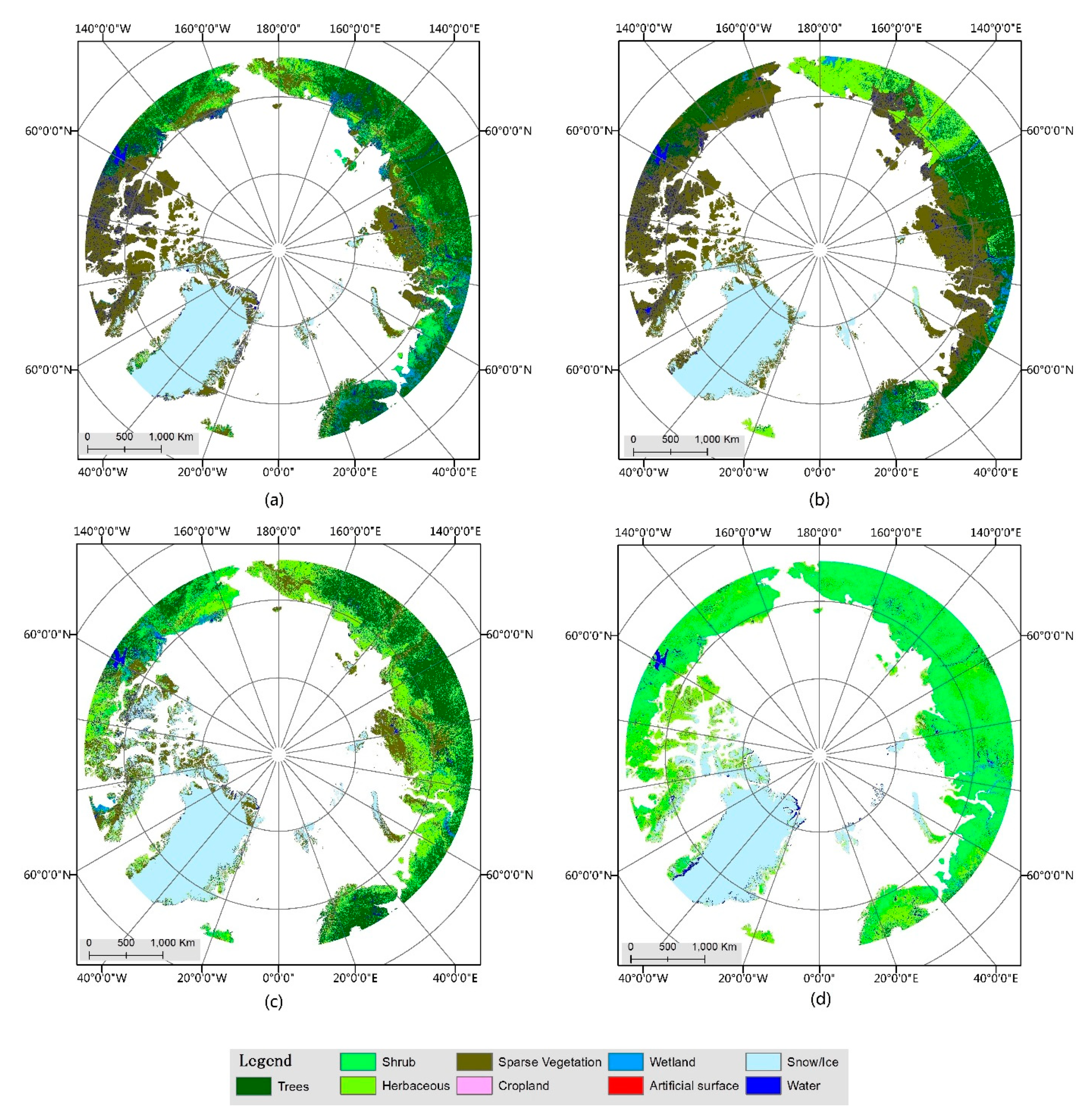
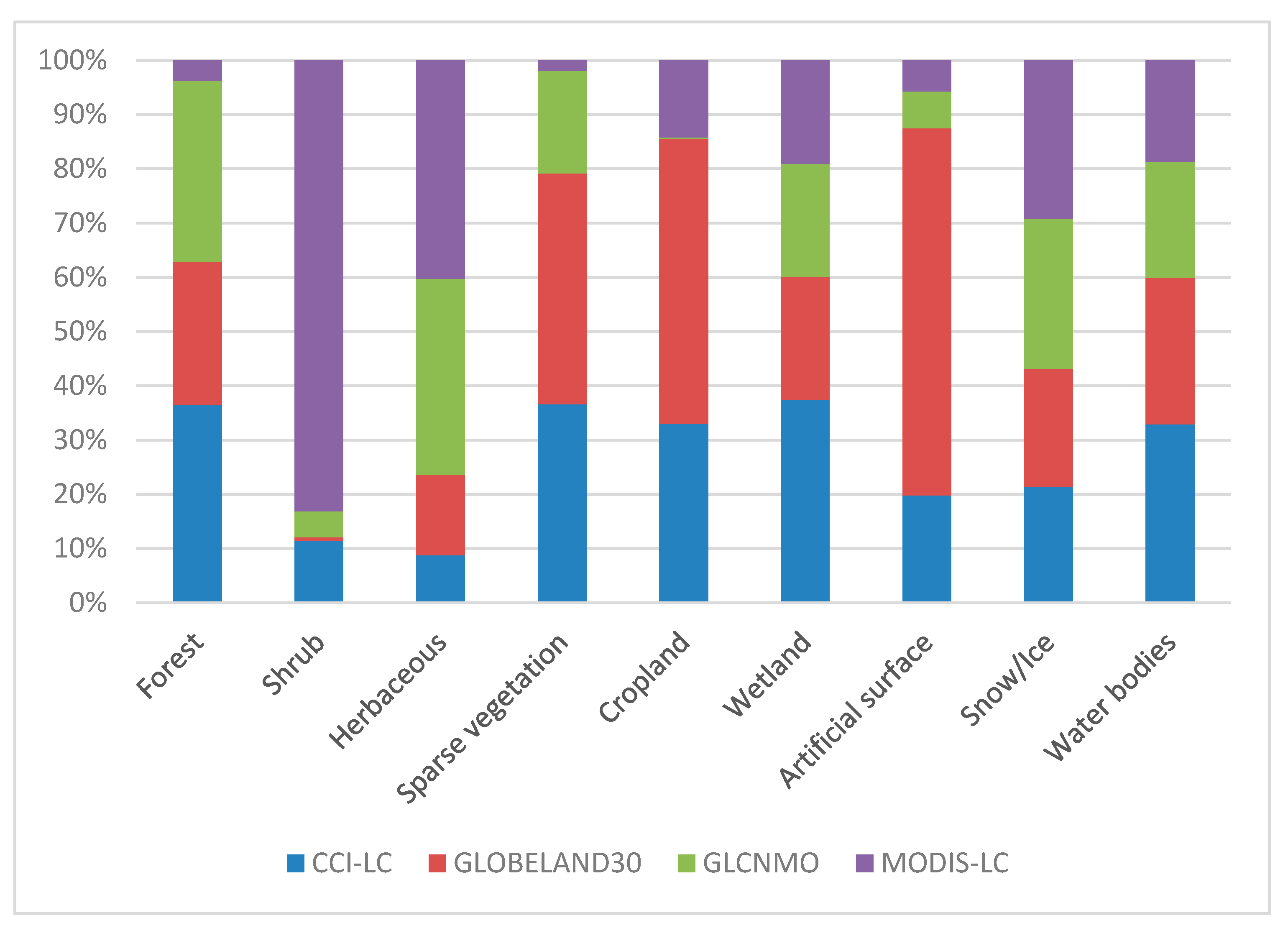
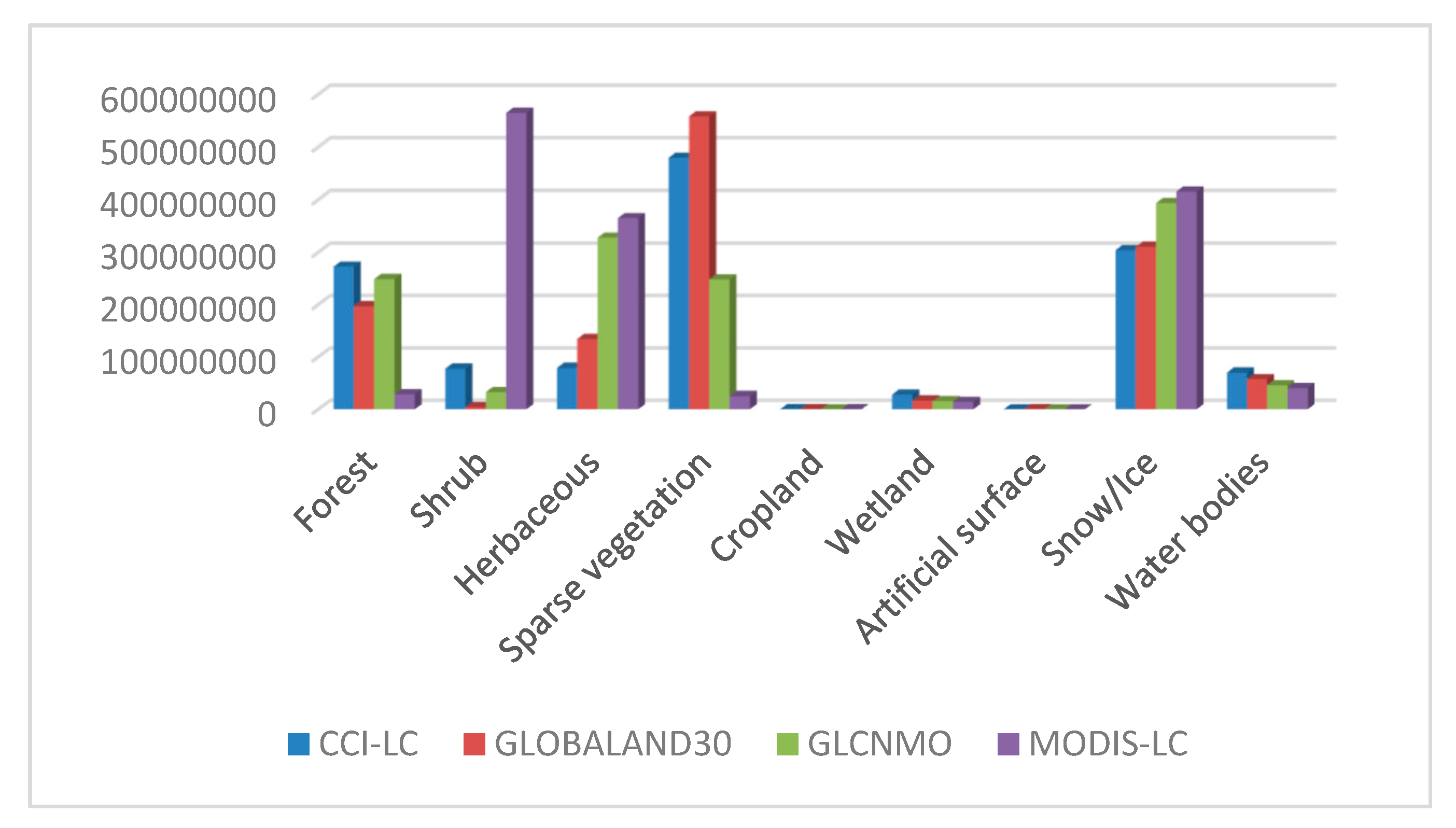
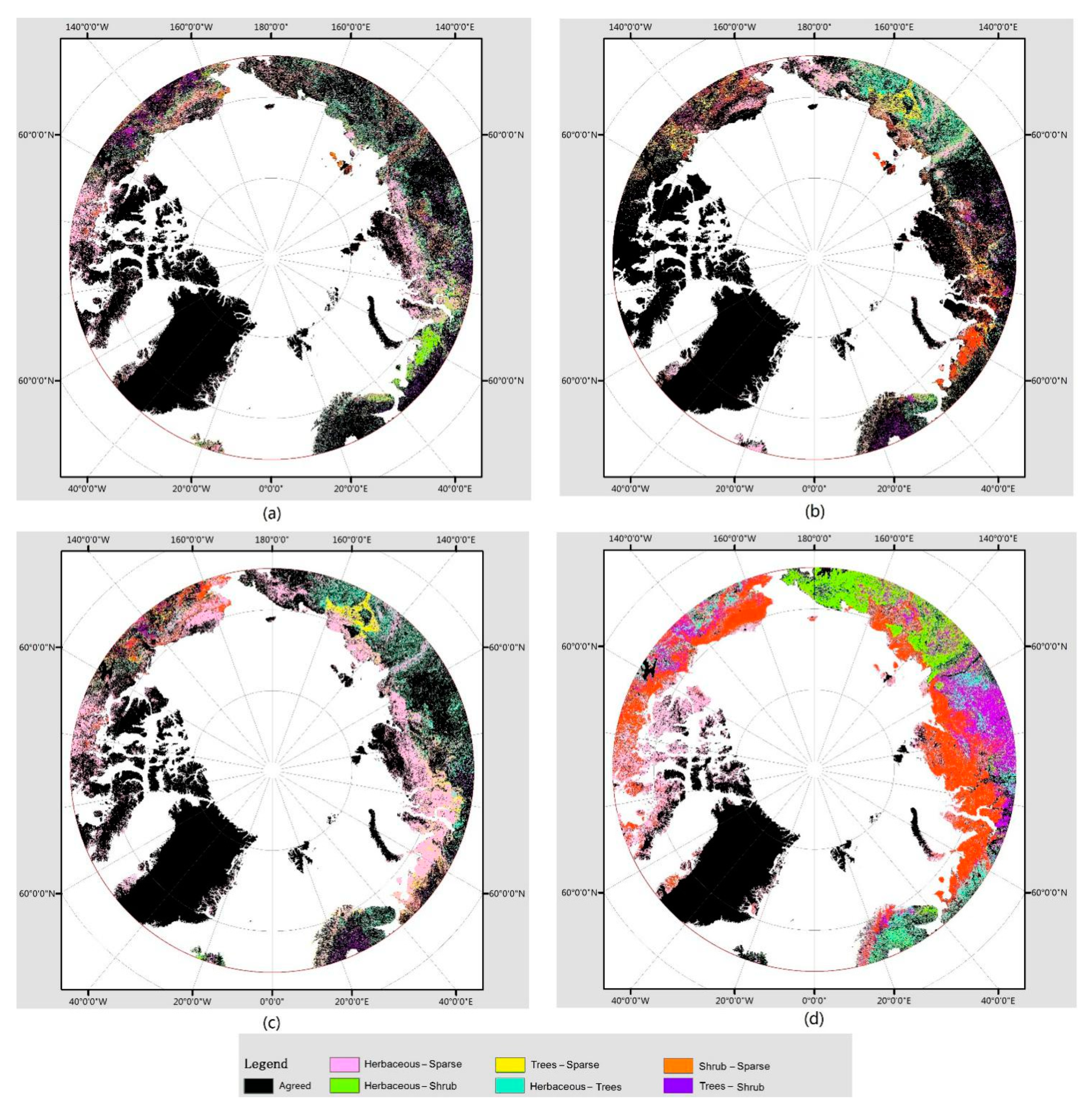
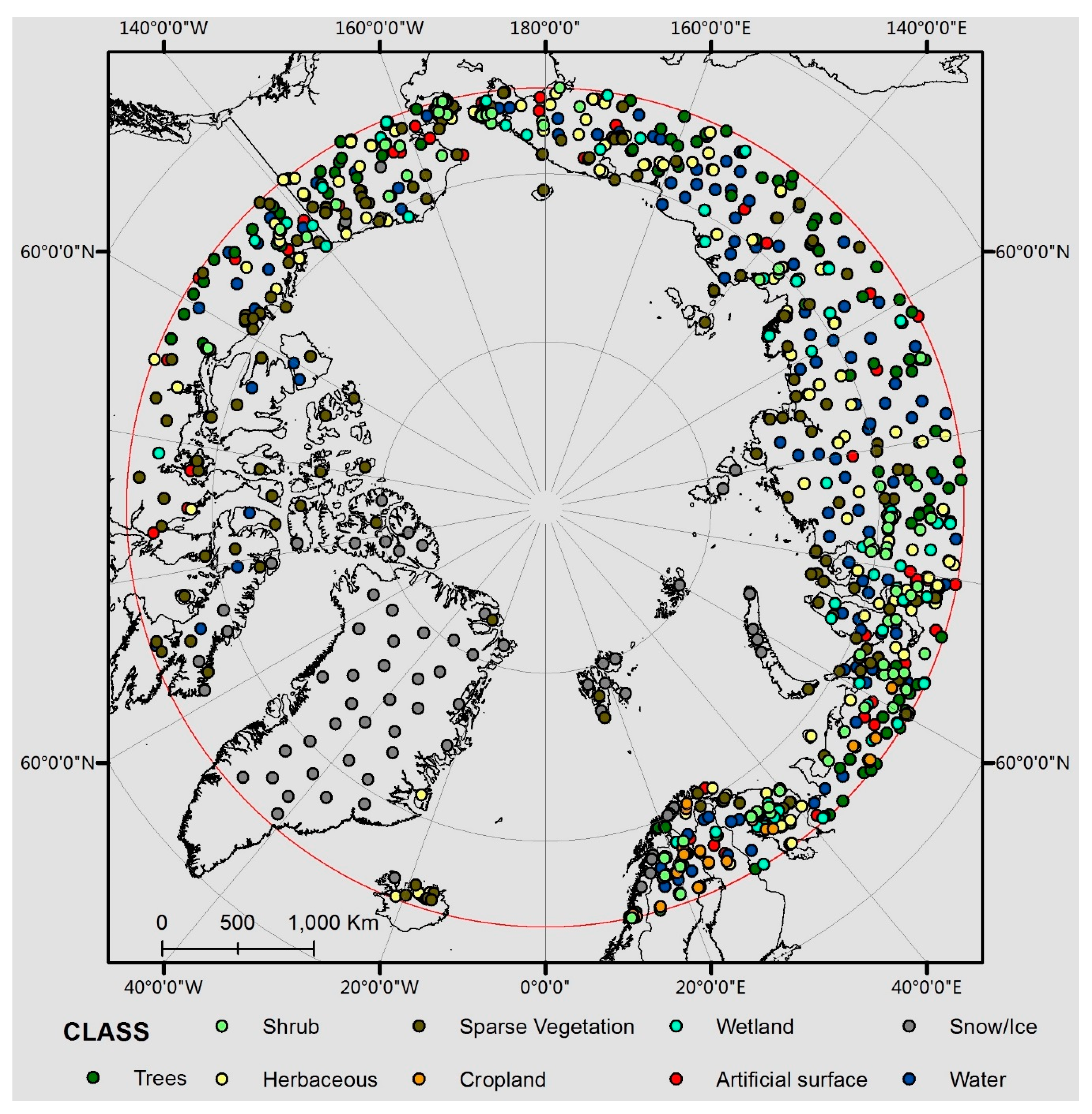
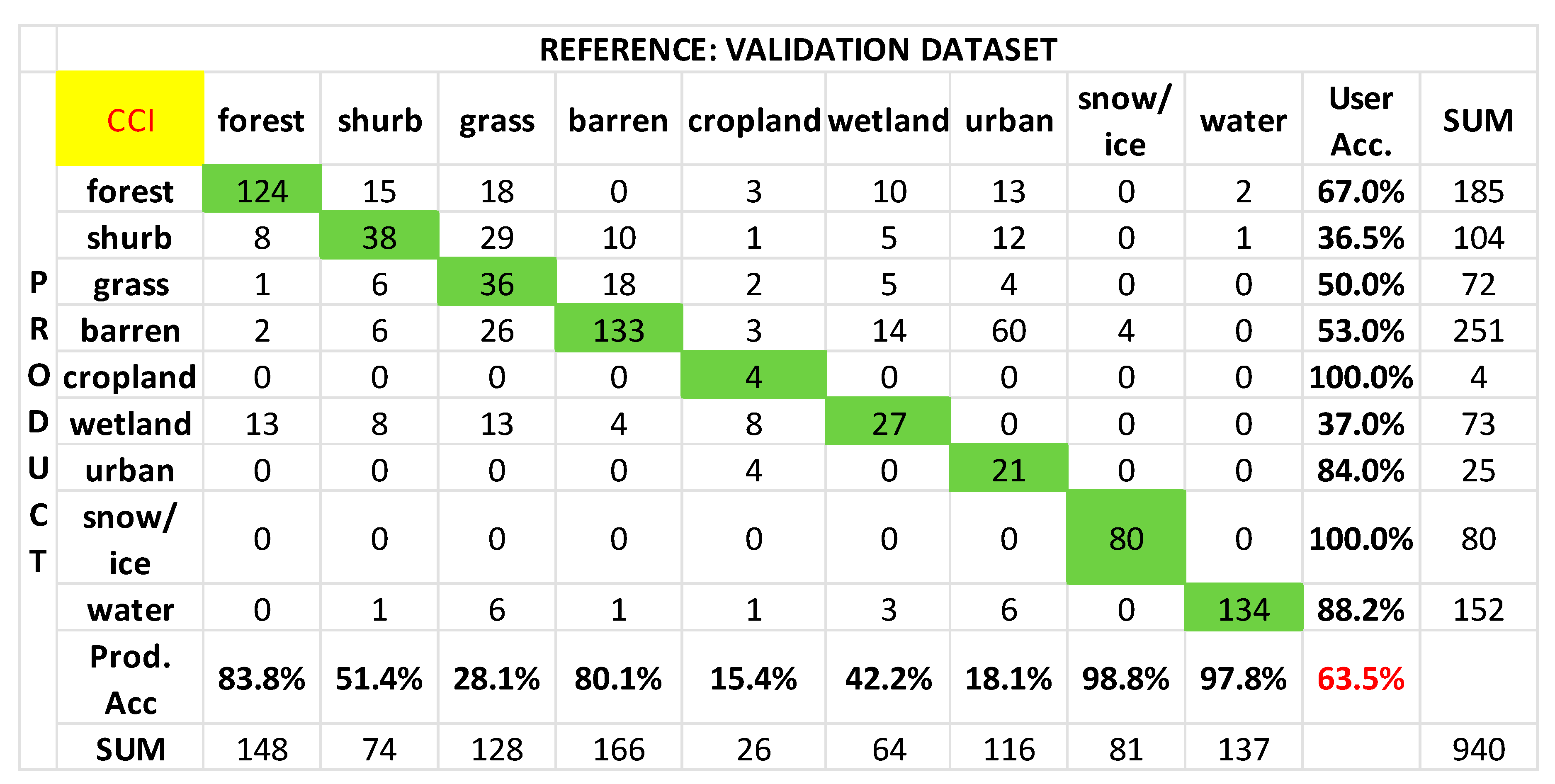
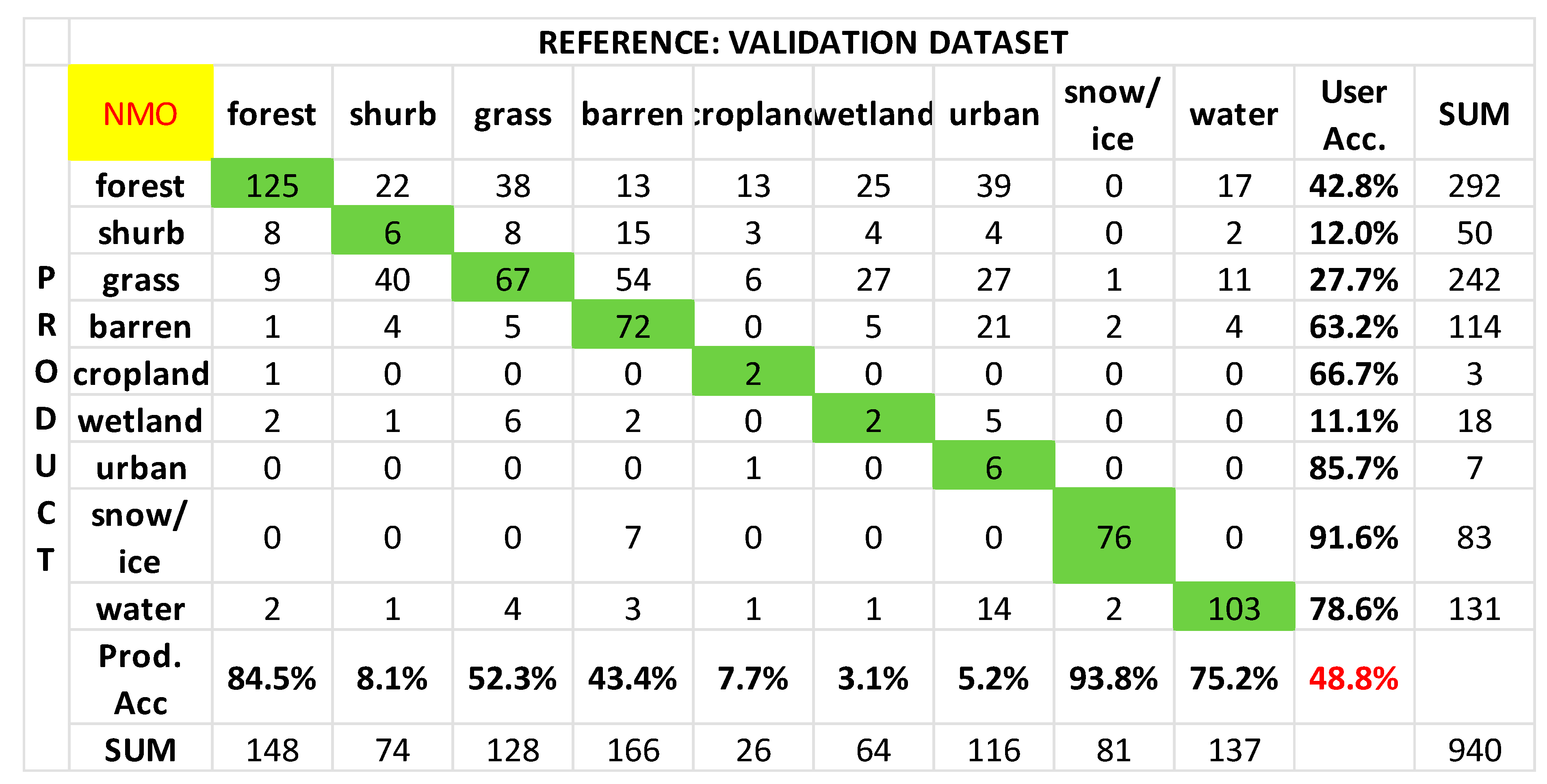
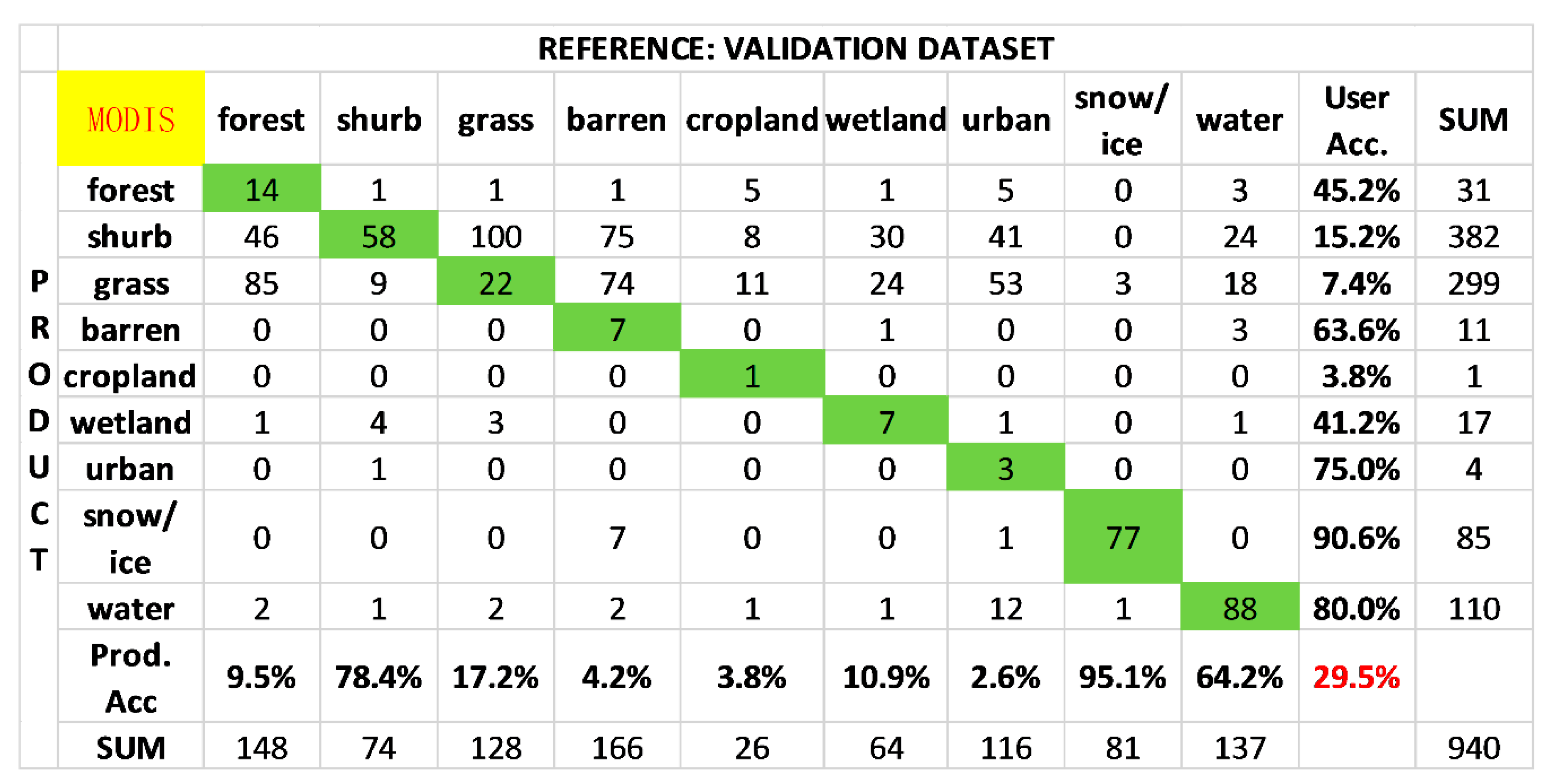
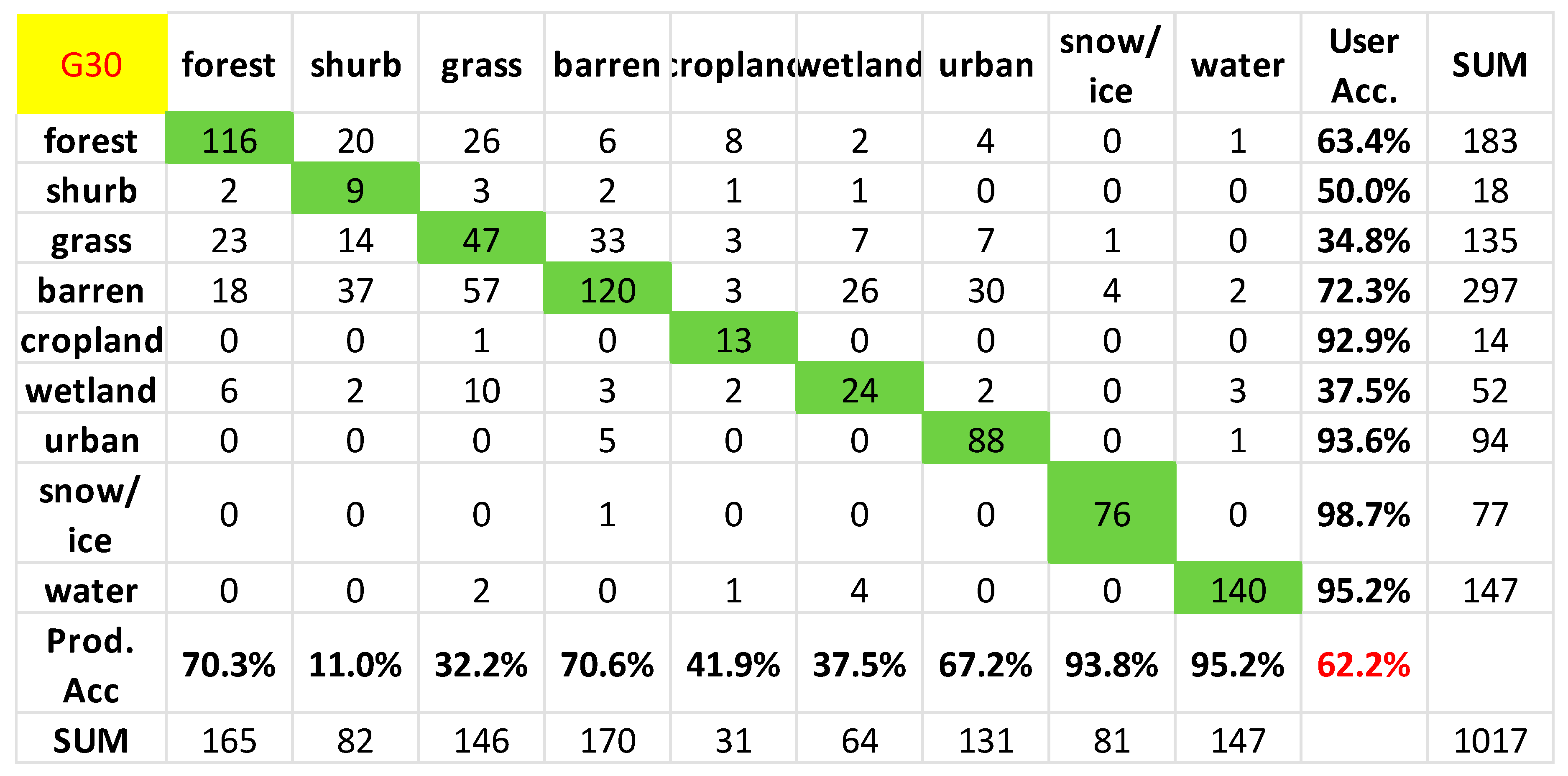

| Data | Time | Resolution | Method | Data Source/Sensor | Classification System | Overall Accuracy |
|---|---|---|---|---|---|---|
| GlobCover | 2005 and 2009 | 300 m | Supervised/unsupervised classification | MERIS | LCCS (22) | 67.10% |
| MODIS LC | (MCD12C1) 2001–2012, (MCD12Q1) 2001–2012, (MCD12Q2) 2001–2013 | (MCD12C1) 0.05° ≈ 5600 m (MCD12Q1 and MCD12Q2) 500 m | Decision-making tree, artificial neural network | Terra | IGBP (17) | 75% |
| GLCNMO | 2003, 2008, 2013 | 1 km | Supervised classification tree method | Terra | LCCS (20) | 87.00% |
| IGBP DISCover | April 1992–March 1993 | 1 km | Unsupervised classification, post-classification processing | NOAA-AVHRR | IGBP (17) | 66.90% |
| GlobeLand30 | 2000, 2010 | 30 m | POK-based | LandsatTM/ETM+ | (10) | 80.50% |
| GLC-SHARE | 2012 | 1 km | Data fusion | GLC2009, CroplandsExtent, MODISVCF 2010, Mangroves, Africover, CorineLC, NorthAmerica | LCCS (11) | 80.20% |
| UMD | April 1992–March 1993 | 1°, 8 km, 1 km | Supervised classification tree method | NOAA-AVHRR | IGBP (14) | 69% |
| CCI-LC | 2000, 2005, 2010 | 300 m | Unsupervised classification | MERISFR, MERISRR SPOT-VGT | LCCS (22) | 74.10% |
| GLC2000 | November 1999–December 2000 | 950 m | Unsupervised classification | SPOT-4 VEGETATION | LCCS (22) | 68.6 ± 5% |
| Target Legend | Code | GLOBALAND30 | Code | MODIS-LC | Code | CCI-LC | Code | GLCNMO |
|---|---|---|---|---|---|---|---|---|
| Forest | 20 | Forest | 1 | Needleleaf evergreen forest | 60 | Broadleaf deciduous closed to open (>15%) | 1 | Broadleaf evergreen forest |
| 61 | Broadleaf deciduous closed (>40%) | |||||||
| 2 | Broadleaf evergreen forest | 62 | Broadleaf deciduous open (15%–40%) | 2 | Broadleaf deciduous forest | |||
| 70 | Needleleaf evergreen closed to open (>15%) | |||||||
| 3 | Needleleaf deciduous forest | 71 | Needleleaf evergreen closed (>40%) | 3 | Needleleaf evergreen forest | |||
| 72 | Needleleaf evergreen open (15%–40%) | 4 | Needleleaf deciduous forest | |||||
| 4 | Broadleaf deciduous forest | 80 | Needleleaf deciduous closed to open (>15%) | |||||
| 90 | mixed leaf type | 5 | Mixed forest | |||||
| 5 | Mixed forest | 100 | Mosaic tree and shrub (>50%) | |||||
| 160 | Wetland tree | 6 | Tree open | |||||
| Shrubland | 40 | Shrubland | 6 | Closed shrublands | 120 | Shrubland | 7 | Shrub |
| 121 | Shrubland evergreen | |||||||
| 7 | Open shrublands | 122 | Shrubland deciduous | |||||
| Herbaceous | 30 | Grassland | 8 | Woody savannas | 110 | Mosaic herbaceous cover (>50%) | 8 | Herbaceous |
| 9 | Savannas | |||||||
| 10 | Grasslands | 130 | Grassland | |||||
| Sparse vegetation | 70 | Tundra | 16 | Sparse vegetation | 140 | Lichens and mosses | 10 | Sparse vegetation |
| 150 | Sparse vegetation (<15%) | |||||||
| 152 | Sparse shrub (<15%) | 16 | Bare area, consolidated (gravel, rock) | |||||
| 90 | Bare area | 153 | Sparse herbaceous cover (<15%) | |||||
| 200 | Bare areas | 17 | Bare area, unconsolidated (sand) | |||||
| 201 | Consolidated bare areas | |||||||
| 202 | Unconsolidated bare areas | |||||||
| Cropland | 10 | Cropland | 12 | Cropland | 10 | Cropland | 11 | Cropland |
| 11 | Herbaceous cove | |||||||
| 14 | Cropland/vegetation mosaic | 30 | Mosaic cropland (>50%)/natural vegetation | 13 | Cropland/other vegetation mosaic | |||
| 40 | Mosaic natural vegetation | |||||||
| Wetland | 50 | Wetland | 11 | Permanent wetlands | 180 | Wetland shrub or herbaceous | 15 | Wetland |
| Urban | 80 | Urban | 13 | Urban | 190 | Urban areas | 18 | Urban |
| Snow/ice | 100 | Snow/ice | 15 | Snow/ice | 220 | Permanent snow and ice | 19 | Snow/ice |
| Water bodies | 60 | Water bodies | 0 | Water bodies | 210 | Water bodies | 20 | Water bodies |
© 2019 by the authors. Licensee MDPI, Basel, Switzerland. This article is an open access article distributed under the terms and conditions of the Creative Commons Attribution (CC BY) license (http://creativecommons.org/licenses/by/4.0/).
Share and Cite
Liang, L.; Liu, Q.; Liu, G.; Li, H.; Huang, C. Accuracy Evaluation and Consistency Analysis of Four Global Land Cover Products in the Arctic Region. Remote Sens. 2019, 11, 1396. https://doi.org/10.3390/rs11121396
Liang L, Liu Q, Liu G, Li H, Huang C. Accuracy Evaluation and Consistency Analysis of Four Global Land Cover Products in the Arctic Region. Remote Sensing. 2019; 11(12):1396. https://doi.org/10.3390/rs11121396
Chicago/Turabian StyleLiang, Li, Qingsheng Liu, Gaohuan Liu, He Li, and Chong Huang. 2019. "Accuracy Evaluation and Consistency Analysis of Four Global Land Cover Products in the Arctic Region" Remote Sensing 11, no. 12: 1396. https://doi.org/10.3390/rs11121396
APA StyleLiang, L., Liu, Q., Liu, G., Li, H., & Huang, C. (2019). Accuracy Evaluation and Consistency Analysis of Four Global Land Cover Products in the Arctic Region. Remote Sensing, 11(12), 1396. https://doi.org/10.3390/rs11121396




